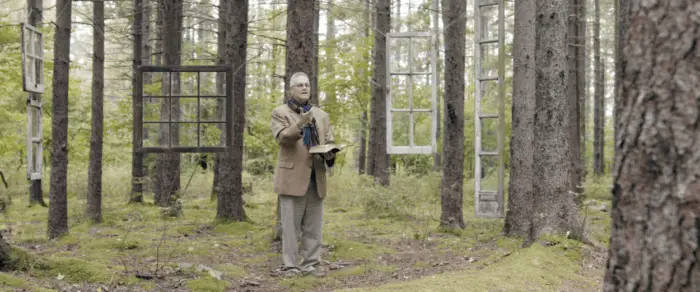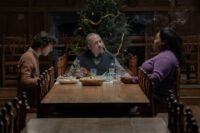To be from the Appalachian region of the United States is to be inherently misunderstood. When people think of West Virginia, they likely think of the John Denver song “Take Me Home, Country Roads” (which isn’t really about West Virginia) or one of the less-than-kind representations of the state in pop culture. For many, the state has been written off as a forgotten place. A place whose value has been in coal, and, as we pivot to greener resources, is being left behind. Earlier this year, Elaine McMillion-Sheldon’s King Coal proved to be both a reflective ode to the region’s past and a hope for the future. Also looking to the future of West Virginia are Clara Lehmann and Jonathan Lacocque, the filmmakers behind O Pioneer.
Named after the famous Walt Whitman poem, O Pioneer is a reckoning. This lyrical documentary asks if we’re at a point in our society that requires a new definition for the word “pioneer.” In its traditional usage, the pioneer is the explorer, the first person to survey a new land. Pioneers were filled with a boisterous sense of adventure. In our current society, we don’t have new places to traverse, so what does that mean for the legacy of the pioneer? Lehmann and Lacocque argue that a pioneer is still at the forefront of exploration and change, but the pioneers we need now are far more humble. O Pioneer follows a blacksmith (Tim ‘Beard’ Hibbs), a seamstress (Nellie Rose Gundersen Davis), and a chaplain (James Morley) as they navigate through the impacts of Covid-19 and use their talents to try to mend this weary world.

O Pioneer is a tapestry of artforms on display, and not just in the works of the film’s subjects, although those are nothing to slouch at. Nellie’s beautiful, hand-dyed cloth flutters in the wind on a mountaintop, embers fly as Tim constructs angel wings, and James’ lyrical words dance through the forest. Our guide for the film is Kaïa Kater, who performs a spoken-word poem and one of her songs, “Poets Be Buried.” She’s not the only musical interlude in the film. Tim’s daughter, Eliza, plays a touching, melancholy version of David Bowie’s “Space Oddity” in a field with the Green Bank radio telescope in the background. In the ashes of Nellie’s father’s house, her friend, Heather Hannah, plays her song “Home” as a farewell to a place that no longer exists.
Directors Lehmann and Lacocque are also the founders of Coat of Arms, a creative studio that has made animations for companies like Google, SXSW, and more. Their talent for animation is on full display in O Pioneer. The film was shot during Covid, and James was working as a hospital chaplain at the time. As we all remember, hospitals severely limited who was allowed inside, and James’ hospital knew the misfortune of having the first confirmed Covid death in the United States. There was no way the filmmakers would have been able to film James at work, so he comes alive in gorgeous animations. We’re able to see him giving last rites at the hospital, and as a young child falling in love with the concept of preaching as his grandmother watches. The animation gives life to these memories that the filmmakers were unable to capture.

James’ story isn’t the only one that receives an animated treatment. Nellie and Tim are also given their own style of animation to allow audiences a peek inside their lives. Tim’s style is very modern to match a story he tells early on about astronauts. He equates the early days of isolation and quarantine to what it must be like for astronauts living in orbit. Lehmann and Lacocque send Tim into space with his long beard flowing out of his helmet. This ultra-modern look is vastly different from Nellie’s loose, flowing style of animation. It fits her work as a seamstress; a funky, free interpretation of who Nellie is as a person. All three styles of animation speak to these people, the work they’ve done, and the future they’re building toward.

As much as O Pioneer is about looking to what is to come, there’s a deep reverence for where West Virginia (and these subjects) has been. Archival footage is woven throughout in a way that pays respect to the history of the region. Each of the subjects also naturally mentions something from a family member that they hold dear to them. For James, it’s a bowl, a hammer for Tim, and a button-up with a missing button for Nellie. Each of them mentions how their chosen object is something that connects them to a person who might not be alive anymore and how it grounds them. It’s a stark reminder to us all that objects don’t exist merely to have or to own, but can have a purpose deeper than intended. They can connect us to the other people on this planet and remind us that our ability to love is something that humanity shares.
O Pioneer is a verité approach to a documentary film. It’s not bogged down by talking heads in fancy rooms. The film is an immersive, magical realist tapestry of life. It’s a film that takes pride in being from West Virginia and showing off all the state has to offer. More than its famous natural resources or its stereotypes, O Pioneer stands as a beacon for the reality of West Virginia and the people who live there. A humble but proud call to the pioneer in all of us.
For more information about O Pioneer and upcoming screenings, check out the official website.




